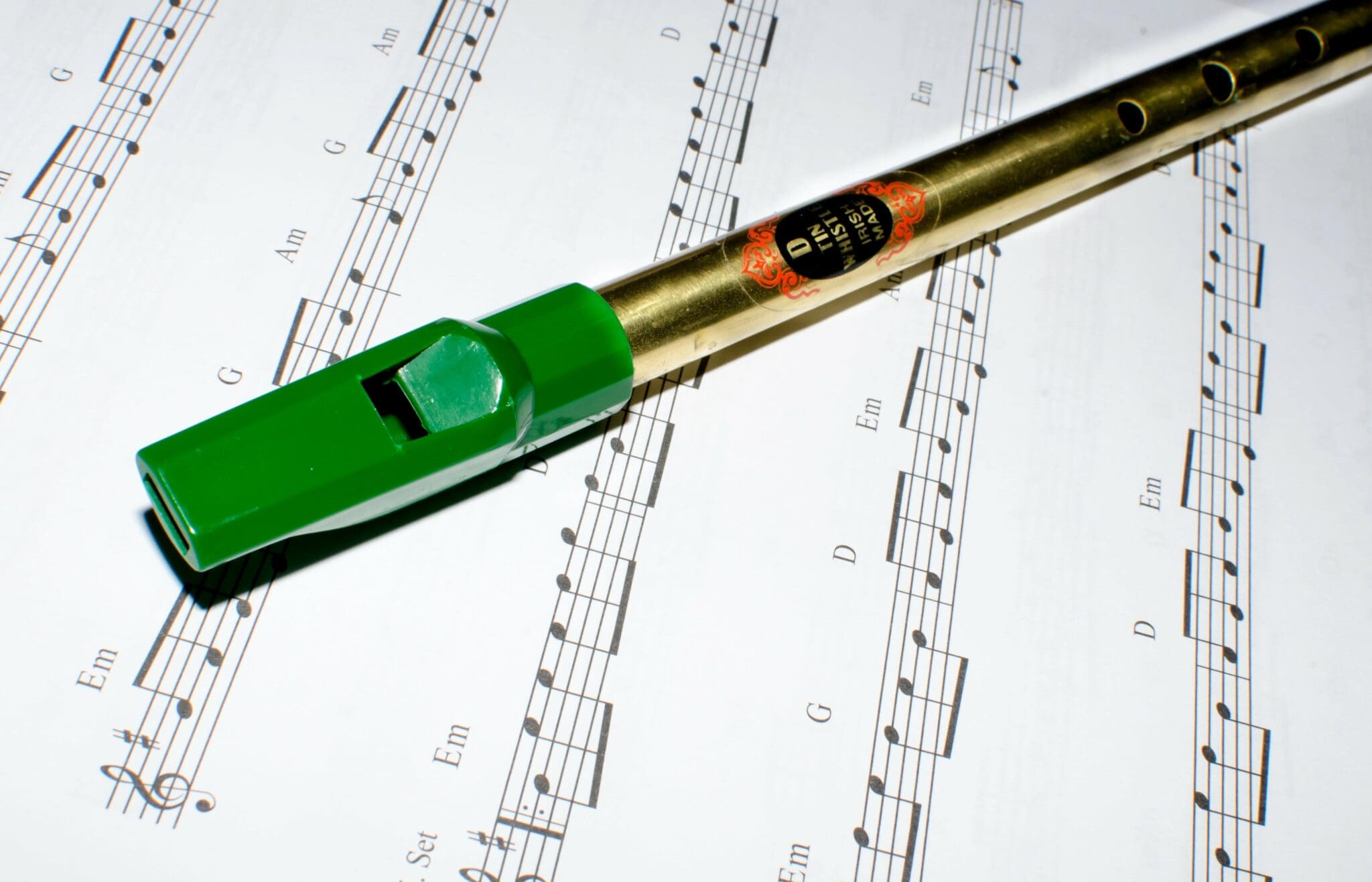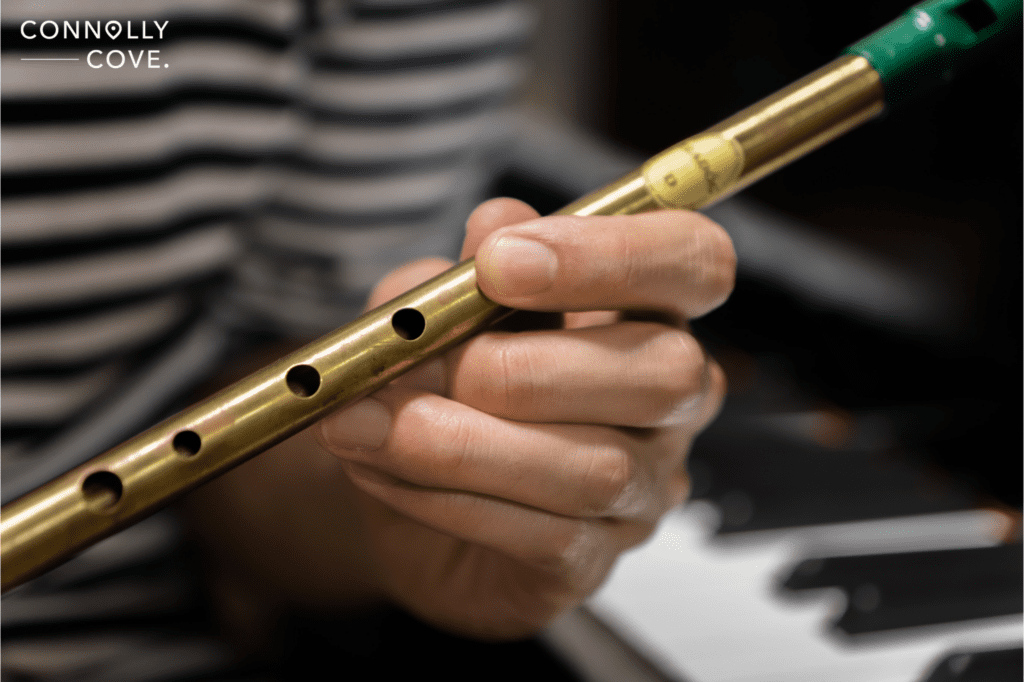Indulge in the Melodies of the Tin Whistle- Ireland’s Popular Instrument

Updated On: April 08, 2024 by Ciaran Connolly
Like everything else, cultures develop their individuality through things. These things extend to almost everything, like music, food, architectural designs, and, sometimes, attire. Speaking of music, its sound has an audible language. No matter what language you speak, it always does talk to you. It is an instrument of harmony, literally and metaphorically.
Music is capable of touching your soul even if it comes from a culture different from yours. And that is the magic of it. We always hear about the fact that people have different tastes in music. To get to the main point, Ireland is one of the countries that has a unique heritage. It may have many similarities with other European countries, yet it maintains its own identity. Going back to the power of music, Ireland developed its genre through the Tin Whistle instrument.
Ireland offers us tons of new things to learn about, and the tin whistle is one of them. In this article, you will learn all you need to know about this special musical instrument.
Table of Contents
What is the tin whistle?

The tin whistle is an instrument that belongs to the woodwind instrument. Thus, it is a simple woodwind instrument with six holes. More precisely, it belongs to the branch of the duct flute family. These flutes are mouthpieces that resemble those of the ordinary whistle. The whistle works by the player guiding its breath into the cutting edge, which is how it produces sound. The mouthpiece made the flute very easy and enjoyable to play without requiring any special blowing techniques.
This flute, in particular, has been highly associated with Celtic heritage. The Irish have always used this instrument in their music. Those who play it are referred to as tin whistlers. Woodwind instruments are plentiful; however, some have criteria different from others. The tin whistle falls into the category that holds the Native American flute, the fipple flute, and the recorder.
Other Names for the Tin Whistle
People refer to it with more than one name. This includes the penny whistle or the penny flute. Those are some of the most common names; however, there are more than you expect. The names include the Scottish penny whistle and, in some cases, it is written that way, Pennywhistle. It is also called the Irish Whistle, Clarke London Flageolet, English Flageolet, Tin Flageolet, and Belfast Hornpipe. In the Irish language, people call the tin whistle the feadóg stáin or just the feadóg.
The Reason for its name- the Penny Whistle
The whistle had always been affordable, especially in the past times when it first appeared. Surprisingly, this popular instrument that shapes Celtic music was once considered a toy. For that reason, children used to play with them more than adults ever did. Ireland’s tradition suggested paying a penny for children or street musicians who played the whistle. That was where the name came from. People called it the penny whistle, for they paid a penny each time they heard it. But, other sources claim a different reason for the naming. In the 19th century, people purchased the whistle for only a penny. Hence the name. Unexpectedly, the two names of the instrument- penny whistle and tin whistle- became popular only during the 20th century.
History Of The Whistle
Woodwind instruments come in a wide range of types. One of these types is the fipple flutes; they possess a broad family that includes the tin whistle. However, the fipple flutes have always had different forms according to their cultures. This allowed us to witness a more comprehensive array of whistles and flutes from all over the world. Interestingly, every culture has its type of fipple flute. Some of these flutes first came into being as well. In other words, each culture has customized its fipple flute nearly throughout the years.
Northern European people started playing an instrument resembling the flute in the early Middle Ages. However, it probably was not the first tin whistle since sources claim the original one belonged to Ireland. That said, Ireland possessed remains of Norman bone whistles that people came to know in the 12th century. Experts found those bones in a cave in Slovenia during that time. They believed that they were at least 45,000 years old. How the people blew the Slovenian flute for the first time remains mysterious. Conversely, over time, the flute’s blowing methods developed into more than one type. Different flute-blowing methods have included the notch flute, duct flute, side-blown flute, an end-blown flute.
The Whistle in the 19th Century
Whistles and flutes have been around since the beginning of time. However, the evolution of the tin whistle took place in the 17th century. During that time, people referred to whistles of French origin as flageolets. They say that these instruments had a lot to do with the development and evolution of the English flageolet or the penny flute.
The development of the penny flute took place during the 17th and 18th centuries. They were around for a very long time. But, being around did not just grant this instrument the popularity it gained during the 19th century. People included the penny whistle in their Celtic music in the early century. Finally, the instrument found its way to become an integral part of more than a few traditions. Not only that, but it also became the most popular instrument in the Irish Traditional Music. While the instrument’s uniqueness made it significant, some popular whistlers helped in that too. They were the most significant whistlers in the history of the tin whistle. Over and beyond, they aided in making the whistle one of the critical mainstream instruments in Irish music.
The list included Sean Potts, Sean, Mary Bergin, Joanie Madden, Micho Russell, and Paddy Moloney.
The Modern Version Of The Whistle
One of the things that assisted in the popularity of the whistle is its affordability. Many traditional music of different cultures adopted it, mainly Ireland, Scotland, and England. In the past, the fipple plugs of the tin whistle consisted of lead. However, the modern version updated the material used, for the lead was poisonous and had to be used cautiously. Modern whistles consist or nickel-plated brass, yet they have the same mouthpiece. This makes the instrument safe and perfect for children to use.
Whenever a whistler improves in playing, he/she needs to possess a new whistle of a higher quality. Those of higher quality have more features that help in exploiting the player’s potential. Recently, a great number of instrument builders have produced tin whistles that are made by hand yet of a high quality. Those ones are more expensive compared to the other whistles. However, this instrument remains the cheapest among other musical instruments.
The Playing Technique Of The Whistle
The tin whistle is a mouthpiece that contains six holes. You play the notes by using your fingers to either open or close these holes, simple as that. There are high and low notes that you control through your finger pads. It’s a unique technique to produce all of the scale’s notes in their proper sequence. For example, a method is called the “Piper’s Grip.” It’s when the player closes all the holes of the whistle to get to the lowest note of the scale. On the other hand, the sequence of the notes requires going from the bottom and upwards. As we previously mentioned, the first one is produced by closing all the holes. You get to the second note, which leaves the lowest hole open. Besides, you generate the last note, the seventh, with all open.
Adding Ornaments
First, what do ornaments mean? Ornaments are notes you add to embellish the melody. However, they are not essential in producing the melody in the first place. Musicians also refer to them as articulations, which include seven main elements.
Cuts
Cuts are ornaments that require the player to lift their finger but for a split second. The player mustn’t interrupt the flow of the air while lifting the finger. The purpose of this music embellishment is to shift the pitch upward slightly. The cut should be performed at the beginning of the note or right after it produces a sound.
Strikes or Taps
The second ornament is the strike. Some people also refer to it as the tap; they are the same. This ornament quite resembles the cuts; however, there are some differences. The only difference lies in slightly lowering a finger to the whistle to reach a lower note. Taps create additional notes to the melody, but they shall be very prompt. The listeners won’t even realize the slight difference this ornament creates in the note, for it’s not a separate one.
Rolls
Here comes the third ornament: the rolls. This one is a combination of two other ornaments, which are cuts and strikes. The roll is a note that starts with a cut, and then a strike follows. Over and be this ornament hase are two different: the; the long roll and the short roll. There is a difference between both types. The short roll consists of two inaudible notes, for they’re both of the same duration and pitch. Those notes start with a cut, nd the second one is a strike. On the other hand, the long roll consists of three notes that last for the same duration. The first onarts normally without an ornament; the second on a cut; the third on a strike.
Slides
Slides are another ornament in classical music. They’re generated by fingering a note above or below the intended note. Following that, the player gradually shifts the fingering, either below or above. The latter causes the pitch to smoothly lower or raise to the required note.
Vibrato
Vibrato is an ornament that requires either fingering or diaphragmatic technique. It is achieved by closing and opening one of the holes. On the other hand, varying the pressure of the breath generates vibrato, too. However, fingering is the common method of achieving vibrato.
Tonguing
Whistle players use this method by touching the roof of their mouth with their tongues. It usually takes place at the start of a note. The purpose of this ornament is to emphasize specific notes and produce a great rhythm. However, whistle players do not use this tonguing method this often.
Cranns
The Uilleann piping tradition invented the Cranns ornament. Musicians refer to this ornament as either cranns or crans. Cranns may be necessary in producing notes, but whistle players do not need them much. Whistle players only use cranns when it is impossible to use another ornament—the rolls.
Quick tips to learn while playing the tin whistle. Click here
The Importance Of Music In Ireland
Ireland is one country that cherishes music and makes it a significant part of its heritage. The Irish culture values music a lot, and they go for spontaneous performances among people in everyday life. Most importantly, it is all about the performance that goes along with the music. There is usually a social activity associated with music that’s purpose is raising awareness and sharing knowledge. For example, Christmas in Ireland is all about charity. On Christmas Eve, people in Dublin sing in the streets to raise money for people experiencing homelessness. They. They also upload YouTube videos that get shared widely to inspire people worldwide. It reveals the power of the Irish music. Undoubtedly, you will always hear the tin whistle among the vital song on the streets. It is an integral part of showing off the Irish heritage.
Music is influenced by culture, like everything. For instance, you will realize there is a difference between Egyptian and Irish food. A significant difference is that the former allows us to learn more about what the world has in store for us.
Check out the best Irish dishes as well.






